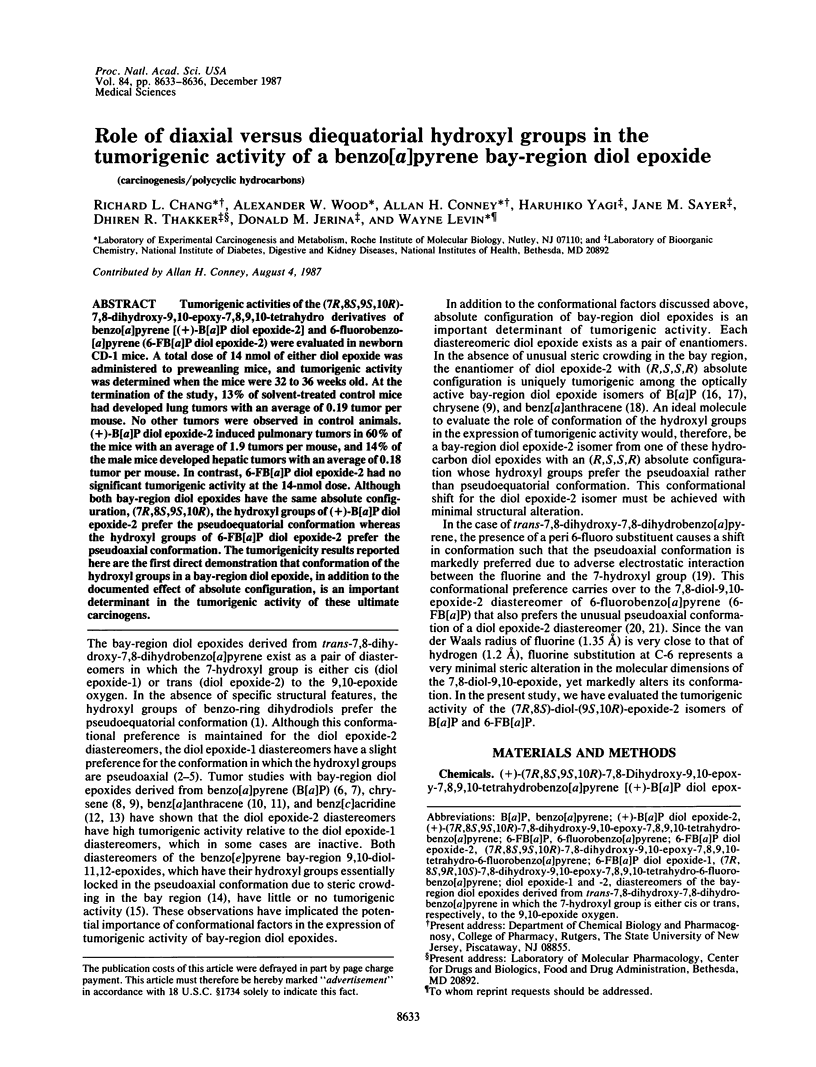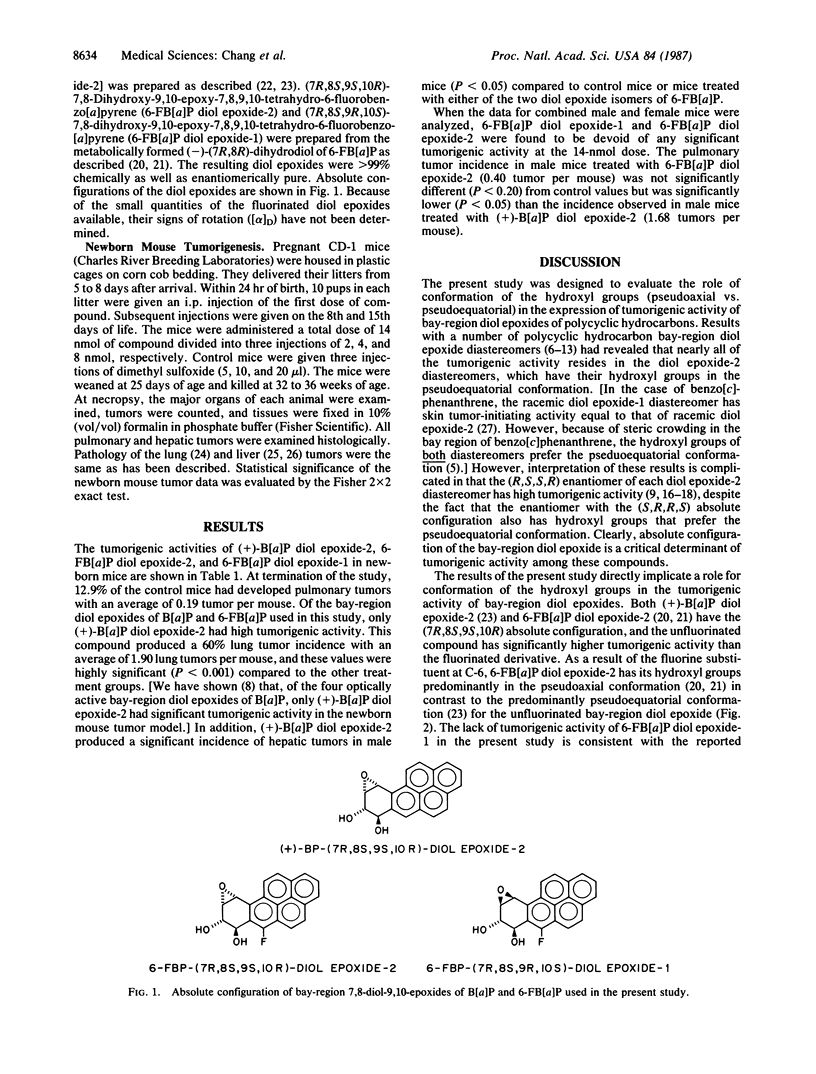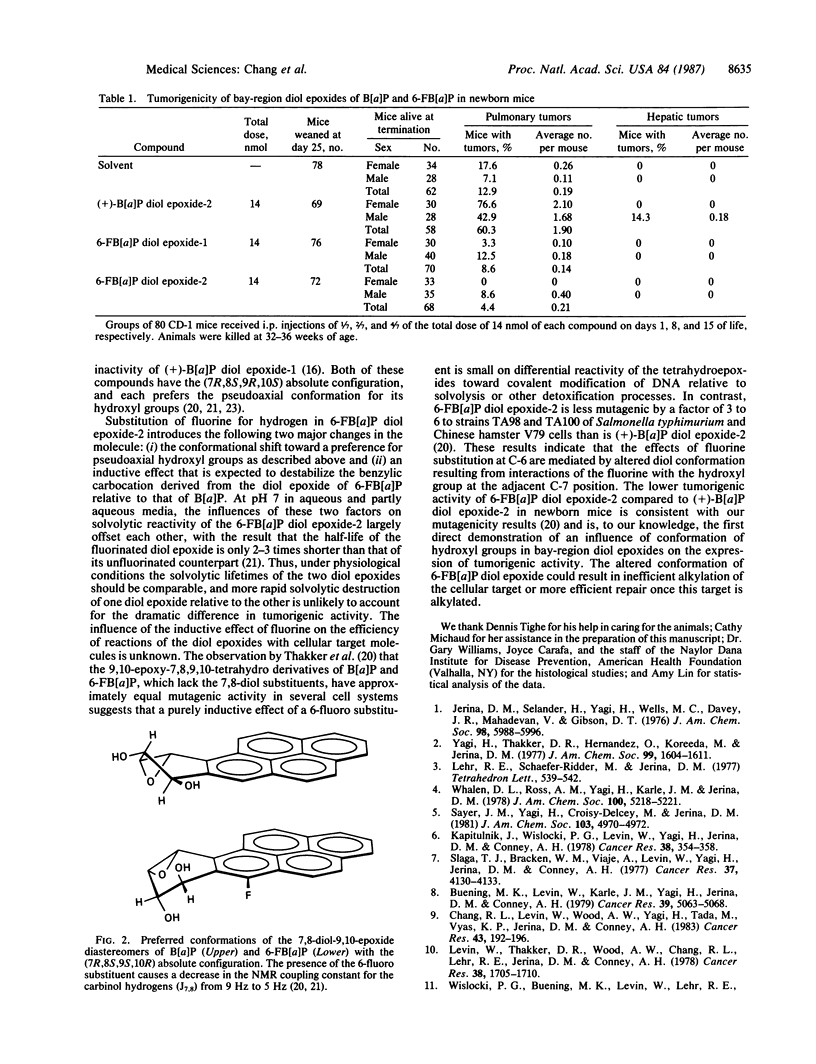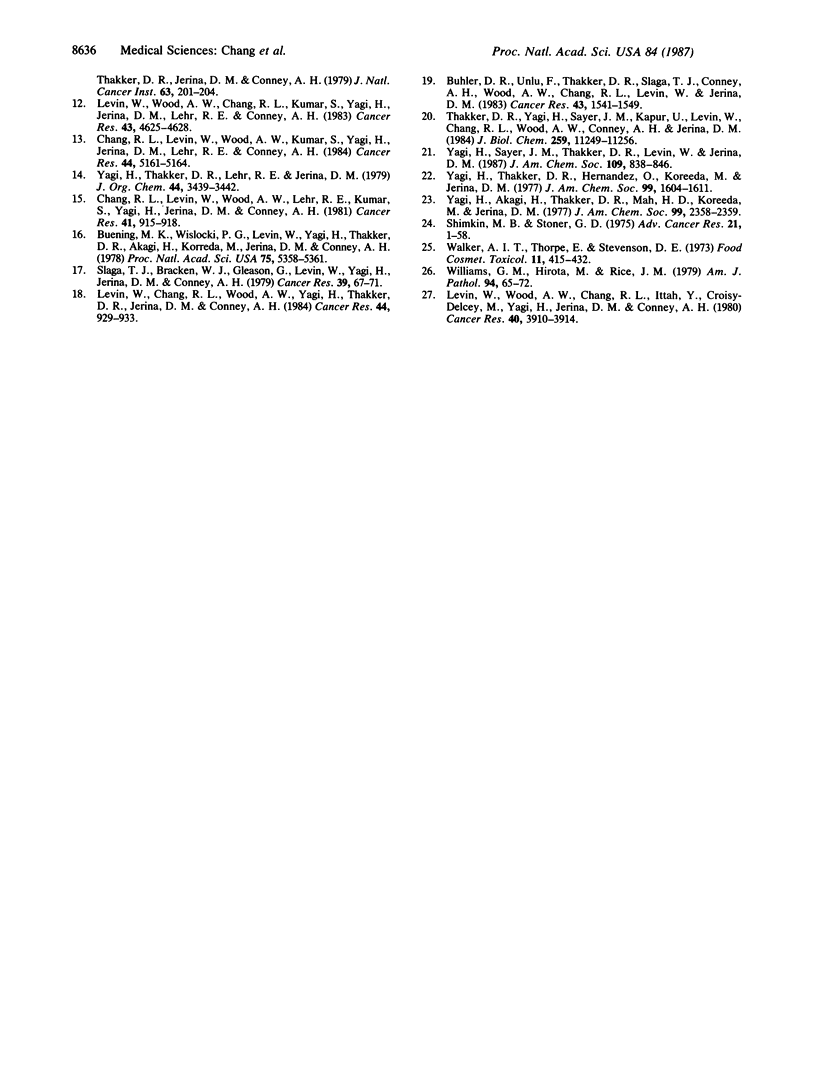Abstract
Tumorigenic activities of the (7R,8S,9S,10R)-7,8-dihydroxy-9,10-epoxy-7,8,9,10-tetrahydro derivatives of benzo[a]pyrene [(+)-B[a]P diol epoxide-2] and 6-fluorobenzo[a]pyrene (6-FB[a]P diol epoxide-2) were evaluated in newborn CD-1 mice. A total dose of 14 nmol of either diol epoxide was administered to preweanling mice, and tumorigenic activity was determined when the mice were 32 to 36 weeks old. At the termination of the study, 13% of solvent-treated control mice had developed lung tumors with an average of 0.19 tumor per mouse. No other tumors were observed in control animals. (+)-B[a]P diol epoxide-2 induced pulmonary tumors in 60% of the mice with an average of 1.9 tumors per mouse, and 14% of the male mice developed hepatic tumors with an average of 0.18 tumor per mouse. In contrast, 6-FB[a]P diol epoxide-2 had no significant tumorigenic activity at the 14-nmol dose. Although both bay-region diol epoxides have the same absolute configuration, (7R,8S,9S,10R), the hydroxyl groups of (+)-B[a]P diol epoxide-2 prefer the pseudoequatorial conformation whereas the hydroxyl groups of 6-FB[a]P diol epoxide-2 prefer the pseudoaxial conformation. The tumorigenicity results reported here are the first direct demonstration that conformation of the hydroxyl groups in a bay-region diol epoxide, in addition to the documented effect of absolute configuration, is an important determinant in the tumorigenic activity of these ultimate carcinogens.
Full text
PDF



Selected References
These references are in PubMed. This may not be the complete list of references from this article.
- Buening M. K., Levin W., Karle J. M., Yagi H., Jerina D. M., Conney A. H. Tumorigenicity of bay-region epoxides and other derivatives of chrysene and phenanthrene in newborn mice. Cancer Res. 1979 Dec;39(12):5063–5068. [PubMed] [Google Scholar]
- Buening M. K., Wislocki P. G., Levin W., Yagi H., Thakker D. R., Akagi H., Koreeda M., Jerina D. M., Conney A. H. Tumorigenicity of the optical enantiomers of the diastereomeric benzo[a]pyrene 7,8-diol-9,10-epoxides in newborn mice: exceptional activity of (+)-7beta,8alpha-dihydroxy-9alpha,10alpha-epoxy-7,8,9,10-tetrahydrobenzo[a]pyrene. Proc Natl Acad Sci U S A. 1978 Nov;75(11):5358–5361. doi: 10.1073/pnas.75.11.5358. [DOI] [PMC free article] [PubMed] [Google Scholar]
- Buhler D. R., Unlü F., Thakker D. R., Slaga T. J., Conney A. H., Wood A. W., Chang R. L., Levin W., Jerina D. M. Effect of a 6-fluoro substituent on the metabolism and biological activity of benzo(a)pyrene. Cancer Res. 1983 Apr;43(4):1541–1549. [PubMed] [Google Scholar]
- Chang R. L., Levin W., Wood A. W., Kumar S., Yagi H., Jerina D. M., Lehr R. E., Conney A. H. Tumorigenicity of dihydrodiols and diol-epoxides of benz[c]acridine in newborn mice. Cancer Res. 1984 Nov;44(11):5161–5164. [PubMed] [Google Scholar]
- Chang R. L., Levin W., Wood A. W., Lehr R. E., Kumar S., Yagi H., Jerina D. M., Conney A. H. Tumorigenicity of the diastereomeric bay-region benzo(e)pyrene 9,10-diol-11,12-epoxides in newborn mice. Cancer Res. 1981 Mar;41(3):915–918. [PubMed] [Google Scholar]
- Chang R. L., Levin W., Wood A. W., Yagi H., Tada M., Vyas K. P., Jerina D. M., Conney A. H. Tumorigenicity of enantiomers of chrysene 1,2-dihydrodiol and of the diastereomeric bay-region chrysene 1,2-diol-3,4-epoxides on mouse skin and in newborn mice. Cancer Res. 1983 Jan;43(1):192–196. [PubMed] [Google Scholar]
- Jerina D. M., Selander H., Yagi H., Wells M. C., Davey J. F., Mahadevan V., Gibson D. T. Dihydrodiols from anthracene and phenanthrene. J Am Chem Soc. 1976 Sep 15;98(19):5988–5996. doi: 10.1021/ja00435a035. [DOI] [PubMed] [Google Scholar]
- Kapitulnik J., Wislocki P. G., Levin W., Yagi H., Jerina D. M., Conney A. H. Tumorigenicity studies with diol-epoxides of benzo(a)pyrene which indicate that (+/-)-trans-7beta,8alpha-dihydroxy-9alpha,10alpha-epoxy-7,8,9,10-tetrahydrobenzo(a)pyrene is an ultimate carcinogen in newborn mice. Cancer Res. 1978 Feb;38(2):354–358. [PubMed] [Google Scholar]
- Levin W., Chang R. L., Wood A. W., Yagi H., Thakker D. R., Jerina D. M., Conney A. H. High stereoselectivity among the optical isomers of the diastereomeric bay-region diol-epoxides of benz(a)anthracene in the expression of tumorigenic activity in murine tumor models. Cancer Res. 1984 Mar;44(3):929–933. [PubMed] [Google Scholar]
- Levin W., Thakker D. R., Wood A. W., Chang R. L., Lehr R. E., Jerina D. M., Conney A. H. Evidence that benzo(a)anthracene 3,4-diol-1,2-epoxide is an ultimate carcinogen on mouse skin. Cancer Res. 1978 Jun;38(6):1705–1710. [PubMed] [Google Scholar]
- Levin W., Wood A. W., Chang R. L., Ittah Y., Croisy-Delcey M., Yagi H., Jerina D. M., Conney A. H. Exceptionally high tumor-initiating activity of benzo(c)phenanthrene bay-region diol-epoxides on mouse skin. Cancer Res. 1980 Nov;40(11):3910–3914. [PubMed] [Google Scholar]
- Levin W., Wood A. W., Chang R. L., Kumar S., Yagi H., Jerina D. M., Lehr R. E., Conney A. H. Tumor-initiating activity of benz[c]acridine and twelve of its derivatives on mouse skin. Cancer Res. 1983 Oct;43(10):4625–4628. [PubMed] [Google Scholar]
- Shimkin M. B., Stoner G. D. Lung tumors in mice: application to carcinogenesis bioassay. Adv Cancer Res. 1975;21:1–58. doi: 10.1016/s0065-230x(08)60970-7. [DOI] [PubMed] [Google Scholar]
- Slaga T. J., Bracken W. J., Gleason G., Levin W., Yagi H., Jerina D. M., Conney A. H. Marked differences in the skin tumor-initiating activities of the optical enantiomers of the diastereomeric benzo(a)pyrene 7,8-diol-9,10-epoxides. Cancer Res. 1979 Jan;39(1):67–71. [PubMed] [Google Scholar]
- Slaga T. J., Bracken W. M., Viaje A., Levin W., Yagi H., Jerina D. M., Conney A. H. Comparison of the tumor-initiating activities of benzo(a)pyrene arene oxides and diol-epoxides. Cancer Res. 1977 Nov;37(11):4130–4133. [PubMed] [Google Scholar]
- Thakker D. R., Yagi H., Sayer J. M., Kapur U., Levin W., Chang R. L., Wood A. W., Conney A. H., Jerina D. M. Effects of a 6-fluoro substituent on the metabolism of benzo(a)pyrene 7,8-dihydrodiol to bay-region diol epoxides by rat liver enzymes. J Biol Chem. 1984 Sep 25;259(18):11249–11256. [PubMed] [Google Scholar]
- Walker A. I., Thorpe E., Stevenson D. E. The toxicology of dieldrin (HEOD). I. Long-term oral toxicity studies in mice. Food Cosmet Toxicol. 1973 Jun;11(3):415–432. doi: 10.1016/0015-6264(73)90007-2. [DOI] [PubMed] [Google Scholar]
- Williams G. M., Hirota N., Rice J. M. The resistance of spontaneous mouse hepatocellular neoplasms to iron accumulation during rapid iron loading by parenteral administration and their transplantability. Am J Pathol. 1979 Jan;94(1):65–74. [PMC free article] [PubMed] [Google Scholar]
- Wislocki P. G., Buening M. K., Levin W., Lehr R. E., Thakker D. R., Jerina D. M., Conney A. H. Tumorigenicity of the diastereomeric benz[a]anthracene 3,4-diol-1,2-epoxides and the (+)- and (-)-enantiomers of benz[a]anthracene 3,4-dihydrodiol in newborn mice. J Natl Cancer Inst. 1979 Jul;63(1):201–204. [PubMed] [Google Scholar]
- Yagi H., Akagi H., Thakker D. R., Mah H. D., Koreeda M., Jerina D. M. Absolute sterochemistry of the highly mutagenic 7,8-diol 9,10-epoxides derived from the potent carcinogen trans-7,8-dihydroxy-7,8-dihydrobenzol[a]pyrene. J Am Chem Soc. 1977 Mar 30;99(7):2358–2359. doi: 10.1021/ja00449a066. [DOI] [PubMed] [Google Scholar]
- Yagi H., Thakker D. R., Hernandez O., Koreeda M., Jerina D. M. Synthesis and reactions of the highly mutagenic 7,8-diol 9,10-epoxides of the carcinogen benzo[a]pyrene. J Am Chem Soc. 1977 Mar 2;99(5):1604–1611. doi: 10.1021/ja00447a053. [DOI] [PubMed] [Google Scholar]
- Yagi H., Thakker D. R., Hernandez O., Koreeda M., Jerina D. M. Synthesis and reactions of the highly mutagenic 7,8-diol 9,10-epoxides of the carcinogen benzo[a]pyrene. J Am Chem Soc. 1977 Mar 2;99(5):1604–1611. doi: 10.1021/ja00447a053. [DOI] [PubMed] [Google Scholar]


